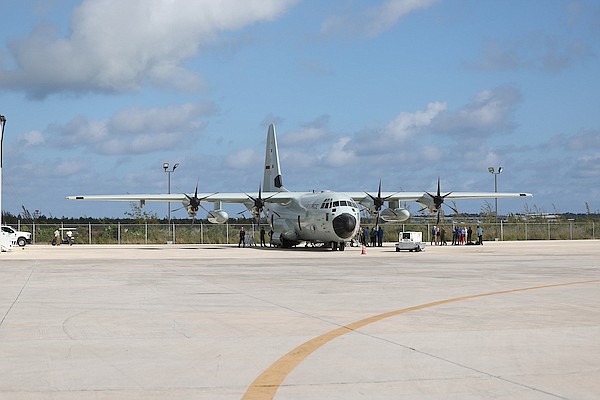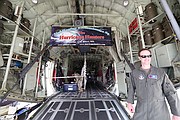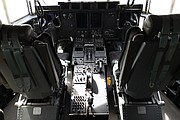A US Air Force WC-130J outfitted for use by the Hurricane Hunters 53rd Weather Reconnaissance Squadron during a press call at Odyssey Aviation yesterday. Photos: Dante Carrer
By KEILE CAMPBELL
kcampbell@tribunemedia.net
THE press toured the Hurricane Hunter Lockheed WC-130J aircraft during a visit by the plane to The Bahamas yesterday. The hurricane hunter flies into tropical cyclones and hurricanes to collect data on the movement, size and intensity of storms under the command of members of the United States Air Force.
The data from hurricane hunters is fed directly to the National Hurricane Centre (NHC) before being shared with the Bahamas’ Department of Meteorology, according to NHC director Dr Michael Brennan.
“They’re telling us exactly where the storm is located, how strong it is,
how big it is, how big is that hurricane force and tropical storm force wind field, how is that gonna tie into how much storm surge or how much rainfall there’s gonna be,” he said.
The data helps to develop the forecast models used for tracking and intensity fore- casts for hurricanes, which make forecasts 10-20 per cent better, according to Dr Brennan, giving credit to members of the Air Force Reserve and the NOAA aircraft operation centre.
Colonel Ellisa Granderson, the 403rd Wing Operation Group Commander, who is responsible for the 53rd weather reconnaissance squadron visiting, said it was the team’s first visit to The Bahamas.
Lieutenant Colonel Kait McLaughlin explained the different types of data sent from the weather reconnaissance aircraft to meteorologists at NHC.
“The first one is what we call ‘high-density observations’, and those are automatic and they’re taken every 30 seconds and we send them out in ten-minute packages, and so that data is continuous and it’s the flight path of the actual airplane and that way you can track us,” she said.
“The next piece is the dropsonde, which is the vertical profile and then one of the other really important pieces we send out is called a ‘vortex data message’, where it will actually tell you where the centre of the storm is, how large the centre is, what the eye looks like. It kind of gives us a little bit of freedom in the remarks section to be descriptive.”
According to Lieutenant Colonel Dave Gentile, pilot of the WC-130J visiting The Bahamas, there is no modern case of a WC-130J aircraft crashing, despite the hazardous nature of missions.
“I think they lost a V29 back in, like, the 70s when they were still flying the weather mission, but since we had the WC-130s, this particular aeroplane, we haven’t ever lost one,” he said.
“They’re very durable, tough aeroplanes. The training is good. We have good standard operating procedures, like there’s a set amount of roll and push before it gets too bad then we’ll call for safety, but otherwise we can go right up into that envelope and the airplane can do it all day.”
Mr Brennan said while storms are “not necessarily getting worse,” their impacts are worsening.
“We’re most confident in the impacts of climate change on the water hazards associated with tropical storms and hurricanes,” he said.
“That’s raising the threat of storm surge, so it’s making the base water level higher, so when the hurricane comes along and pushes that water onto normally dry land, the water is starting at a higher level. We also know that warmer atmosphere holds more moisture and is increasing rainfall totals and rainfall rates, which is worsening flooding from rainfall as well.”
AccuWeather and Colorado State University (CSU) released their predictions for the 2024 Atlantic hurricane season earlier this month. The National Oceanic and Atmospheric Administration’s (NOAA) predictions are expected to be released in late May.
CSU forecast up to 23 named storms, while AccuWeather predicted up to 25. Both predicted an active hurricane season.
Mr Brennan said experts expect La Nina conditions to develop in the Eastern Pacific, which “tends to favour a more active Atlantic hurricane season”.
Acting director of the Bahamas Department of Meteorology Jeffrey Simmons spoke about storms getting worse for low- lying countries like The Bahamas.
“We have seen the devastation that storm surge can do to us because we are so flat,” he said. “What that allows now is for the storm surge to go even further inland, so the more powerful these storms are, depending on which area they’re coming from, we can expect more storm surge.”







Comments
Baha10 1 week, 5 days ago
Thank You USA for this invaluable service provided “free of charge” to our Country for many, many years and for which we have provided no where near enough gratitude … Thank You, Thank You, Thank You 🙏
Sign in to comment
Or login with:
OpenID